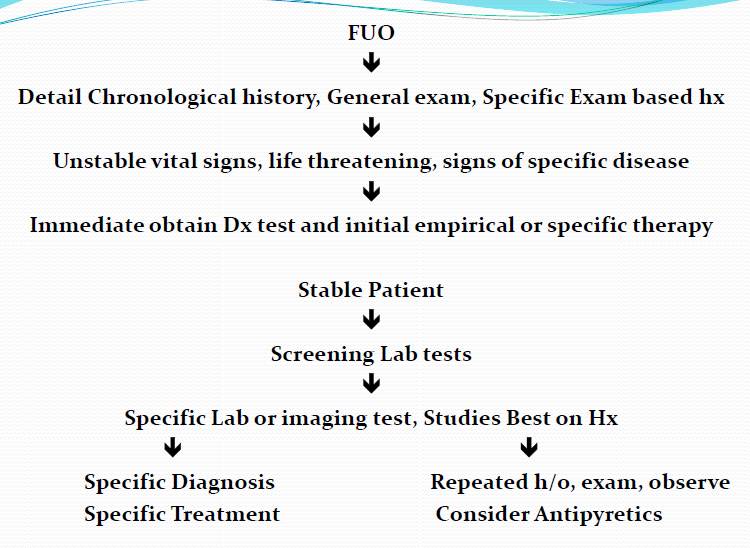For fever of unknown origin it also reached 677. The disease causing the fever must be treated.

Flow Chart Of Fuo Patients Fuo Fever Of Unknown Origin Download Scientific Diagram
But dont let government and pharmaceutical giants figure that out or it will become very costly to treat them.

How to treat fever of unknown origin. If a tumor is found an oncologist a doctor specializing in. Fever of unknown origin means fever that does not resolve itself in the period expected for selflimited infection and whose cause cannot be ascertained despite considerable diagnostic effort 1. Fever of unknown origin FUO in the elderly is an example of a classicmedical syndrome that requires a specific approach.
These target the most likely. Antibiotics will be given for infections. Besides a small dose of 125 mg naproxen 375 mg twice a day and 250 mg 3 times a day were also useful.
Fever of unknown origin FUO was first defined in 1961 by Petersdorf and Beeson and continues to be a clinical challenge for physicians. Once the causative drug is stopped fever almost always resolves within two days. Fever of unknown origin FUO was defined in 1961 by Petersdorf and Beeson as the following.
UFO and FUO phenomena are in parallel metaphorically. Fever of unknown origin FUO was first described by Dr. It is one of the drugs worth a closer look in treatment testing and trials.
If there is no underlying source of your fever ID Care specialists may prescribe nonsteroidal anti-inflammatory drugs and antihistamines to reduce the fever itself. Antipyretics eg ketoprofen flunixin meglumine dipyrone are not typically advocated because the fever can be beneficial and many argue that antipyretic therapy can have a negative impact on immune responses by causing hypothermia and impairing host immune defenses. 950993 in the dosage of 250 mg twice a day.
The list of implicated agents is lengthy and includes some drugs given to treat fever eg. FUOs by definition are disorders with prolonged undiagnosed fevers but fever taken alone is unhelpful. Fever of unknown origin FUO is defined as fever at or above 101F 383C for 3 weeks or more that remains undiagnosed after 3 days of in-hospital testing or during two or more outpatient visits.
3431 Fevers may increase the bactericidal effect of antibiotics and serum and can also decrease the pathogenicity of some pathogens. Although clinicians may have some understanding of the history of clinical thermometry how average body temperatures were established thermoregulation and pathophysiology of fever new concepts are emerging. People whose fevers are thought to have an immune-deficient origin may be treated with broad-spectrum antibiotics.
1 a temperature greater than 383C 101F on several occasions 2 more than 3 weeks duration of illness and 3 failure to reach a diagnosis despite 1 week of inpatient investigation. However if the cause of your FUO is a result of an immunodeficiency condition or virus your treatment plan may include antibiotics or antiviral drugs. Although clinicians may have some understanding of the history of clinical thermometry how average body temperatures were established thermoregulation and pathophysiology of fever new concepts are emerging.
1 This definition has evolved with faster and more accurate diagnostic techniques and changing models of care and a week of hospitalisation is no longer. A doctor who specializes in infections will help with diagnosis evaluation and treatment of infectious diseases. FUO was defined as a temperature of 101F 383 C or higher with a minimum duration of 3 weeks without an established diagnosis despite at least 1 weeks investigation in the hospital.
This definition was later changed to accommodate technological advances. How Is FUO Treated. Commonly several weeks elapse between initiation of the drug and onset of fever.
Treatment should be directed toward the underlying cause as needed once a. In this meta-analysis the success rate was 981 95 CI. If Ivermectin can treat fevers of unknown origin can it also treat fevers of known origin COVID-19.
37 rows Some Causes of Fever of Unknown Origin FUO Fever of unknown origin FUO is body. Fever of unknown origin FUO was first defined in 1961 by Petersdorf and Beeson and continues to be a clinical challenge for physicians. The success rate of the suspected neoplastic fever was 798.
The definition of pyrexia of unknown origin PUO dates back to 1961. In general empiric therapy has little or no role in cases of classic fever of unknown origin FUO. It was described as a persistent fever above 383C 100F that evades diagnosis for at least 3 weeks including 1 week of investigation in hospital.

Fever Of Unknown Origin Clinical Practice Osmosis

Prolonged Febrile Illness And Fever Of Unknown Origin In Adults American Family Physician

An Approach To Fever Of Unknown Origin Fuo Youtube

Prolonged Febrile Illness And Fever Of Unknown Origin In Adults American Family Physician

Fever Of Unknown Origin Cases In Pediatrics

Pediatric Fever Of Unknown Origin American Academy Of Pediatrics

Approach To The Adult Patient With Fever Of Unknown Origin American Family Physician

Prolonged Febrile Illness And Fever Of Unknown Origin In Adults American Family Physician

Fever Of Unknown Origin Approach To Management Medchrome
0 comments:
Post a Comment